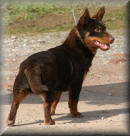|
Lancashire Heelers
A short history.
A LANCY BY A YORKEY.
by
BOB DE-VINE
The Welsh sheepdogs were often called "curs" until about the 1700s, when they broke into types, there were also dogs with short legs that became terrier type and others from about 1650 onwards.
The shepherds of North Wales started, after the lambing season, to drive sheep to the North Midlands and across to Yorkshire - Welsh sheep were good and hardy!
At this time, around the early 1600s there were markets all over England: not only sheep, but cattle, goats, geese and turkeys were driven over the rough tracks, for there were no real roads.
The Welsh shepherds had large dogs for the herding along the tracks, like the Welsh Hillman, The old Welsh Blue and the Welsh Collie, but to help them they had a short-legged long-bodied dog that nipped the heels of the laggard sheep or cattle. The cattle, and especially the sheep, must not be bitten, for this would lame them and reduce there worth. The sheepdogs and the herders were trained not to bite sheep or cattle, but the little dogs could nip them without doing harm. The little dogs were also used to hurry the slow one back into the herd or flock; they were not used to fetch wayward animals back onto the track: this was the job for the longer-on-the-leg dogs.
At the end of the drives, some of both types of dogs were left behind, or had wandered off. From the short-legged, Corgi type dogs left in Lancashire, in the town of Ormskirk (between Wigan and Southport) a type quite its own began to appear. By the 1790s a type of black-and-tan short-legged, prick-eared dog had appeared, much used by butchers for bringing a single beast to the slaughter-house. The early dogs of Ormskirk were long-bodied and short-legged; time passed and shepherds and farmers all over Lancashire took up the breed for general farm work, herding, rat catching, and rabbiting with nets.
. . . and came forth the Lancashire Heeler!
Copyright Bob De-Vine
|


